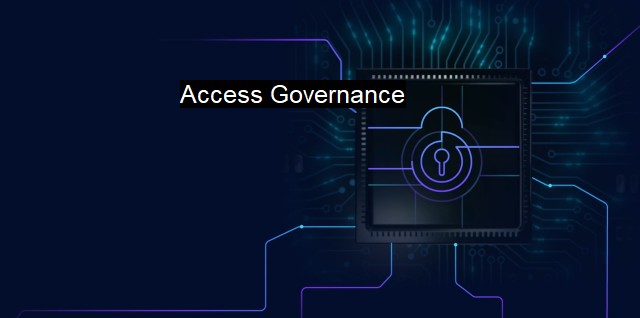What is Access Governance?
Securing Your Organisation's Sensitive Data: The Vital Role of Access Governance in Preventing Cyber Threats
Access Governance, in the context of cybersecurity and antivirus protection, is a significant aspect of the broader discipline of Identity and Access Management (IAM). Simply put, access governance is the process by which organizations monitor, manage, and govern who has access to which resources to ensure that the level of access provided aligns with individuals' roles or responsibilities. The objective is to mitigate information security risks such as data breaches, restrict unauthorized access, minimize access-related issues, and ensure regulatory compliance.Cybersecurity pertains to the practices employed to safeguard systems, programs, and networks from digital assaults, system assaults, or data breaches. These cyber-attacks are often instigated with the intent to extort money from a user by disabling system access or extracting sensitive, private data. In this cybersecurity context, access governance plays a vital role by controlling how these risks are handled and conflict-effected access rights is also managed.
Access governance empowers a more powerful access management system by uniting identity management, access management, and access enforcement. It provides a holistic, streamlined approach that enables system administrators to maintain monitoring and control of the realm for which they are responsible robustly. This makes any attempts to bypass set permissions — an incline usually exploited by viruses and malware much harder.
Set protocols and defined governance give appropriate rights and maintain those rights within necessity limits. Some measures include terminating unnecessary access rights, reducing excessive privileges, and revoking regulatory exposures. This calculated reciprocity between the administrative aspects and security happenings on a system is crucial not only to maintain functionality but also streamline workflows.
In antivirus connection, access governance serves an equally significant role. Antivirus software conducts regular scans to detect and eliminate any software threats that lurk in system corners undetected. while antivirus deals with containing and eliminating threats, access governance is concerned with proactively preventing such threats from coming into the system environment. Properly administered rights leading into a system translate into well-manicured entry points suited only to those who need such access.
Access controls, which remain a principal part of access governance, are safeguards employed to prevent unauthorized access by interfering with the integrity, availability, and confidentiality of information. It provides a melee of aether permissions that run through functions such as creating, editing, viewing, or property deleting of data within a system.
With growing digital threats and data breach incidents, strict access controls need continuous monitoring and managing. In the past, manual administration was dominant, however modern systems now foster automated processes, and access controls are constantly improved so that threats in pivot moments are preemptively handled. Access governance therefore provides an omniscient perspective to access management within an organization.
Lastly, in stricter regulated sectors, such as healthcare, finance or nuclear energy, access governance forms an integral driver maintaining regulatory compliance. Besides, controlled access fortifies data preservation, system health, and public credibility —figuring chiefly within corporate responsibility scopes.
Access governance in earnings realization across core operational aspects from user satisfaction on tasks arrangements through to audits relations in maintaining regulation standards. Given the evolving threat matrix, access governance proves central in ta holistic cybersecurity strategy. Through adept resource accessibility regulations and a well-roundedly managed system workflow, businesses can have assurance in combating escalating network threats for a safer business-exclusive environment.

Access Governance FAQs
What is access governance?
Access governance refers to the processes and policies that organizations use to manage and control access to their information technology resources. Access governance helps to ensure that only authorized individuals have access to sensitive data and systems, and that access is granted based on clearly defined roles and responsibilities.Why is access governance important for cybersecurity?
Access governance is critical for cybersecurity because it helps to minimize the risk of unauthorized access to sensitive data and systems. By ensuring that only authorized individuals have access to specific resources, access governance helps to prevent data breaches, insider threats, and other security incidents. It also helps to ensure compliance with applicable regulations and standards, such as HIPAA and PCI-DSS.What are some best practices for access governance?
Some best practices for access governance include conducting regular access reviews and audits, implementing strong authentication and authorization controls, defining clear roles and responsibilities for access to specific resources, and continuously monitoring access activity for anomalies or suspicious behavior. Other best practices may include implementing a least privilege access model, implementing segregation of duties controls, and providing regular access training and awareness to employees.What is the role of antivirus in access governance?
Antivirus is an important component of access governance because it helps to protect systems and data from malicious software, such as viruses, worms, and trojans. Antivirus software can be used to prevent malware from being installed on computers as well as to detect and remove existing infections. By protecting against malware, antivirus helps to prevent unauthorized access and data theft, which are key risks to cybersecurity.| | A | | | B | | | C | | | D | | | E | | | F | | | G | | | H | | | I | | | J | | | K | | | L | | | M | |
| | N | | | O | | | P | | | Q | | | R | | | S | | | T | | | U | | | V | | | W | | | X | | | Y | | | Z | |
| | 1 | | | 2 | | | 3 | | | 4 | | | 7 | | | 8 | | |||||||